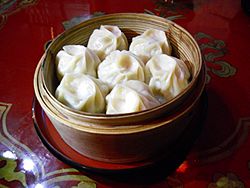Buuz facts for kids
 |
|
| Type | Dumpling |
|---|---|
| Place of origin | Mongolia, Buryatia |
| Main ingredients | Dough, mutton, or beef |
Buuz is a tasty dumpling from Mongolia and Buryatia. It is a popular dish, especially during the Tsagaan Sar (Lunar New Year) celebration. Buuz are steamed and filled with meat. You can find them in homes, restaurants, and cafes, especially in Ulaanbaatar, the capital city.
Contents
What is Buuz?
Buuz is a special kind of dumpling that is steamed. It is a very important part of Mongolian and Buryatian food. People usually eat buuz at home during the Tsagaan Sar, which is the Lunar New Year. Today, you can also find buuz in many restaurants and small cafes. They are popular in Ulaanbaatar, the capital city of Mongolia.
Buuz and its History
Buuz is Mongolia's version of a steamed dumpling. You can find similar dumplings all over Asia. The word "buuz" comes from the Chinese word "baozi". "Baozi" is the Mandarin Chinese word for a steamed dumpling. This shows where buuz might have first come from.
When People Eat Buuz
People eat buuz a lot throughout the year. But they are most important during the Mongolian New Year. This celebration usually happens in February. Families prepare many buuz in the weeks before the New Year. They often leave them outside to freeze. When it's time to eat, they are steamed. People enjoy buuz with salads and fried bread. They also drink suutei tsai, which is Mongolian tea.
How Buuz is Made
Buuz are made with a simple dough and a tasty meat filling. The main ingredients are usually mutton or beef.
Ingredients for Buuz
The meat inside buuz is usually minced. This means it is cut into very small pieces. The meat is mixed with onion or garlic. It is also seasoned with salt. Sometimes, cooks add other flavors. These can include sprouted fennel seeds or other herbs that grow in the season. Some people also add mashed potato, cabbage, or rice to the filling.
Preparing and Cooking Buuz
First, the meat mixture is shaped into a small ball. This ball is then placed inside a small piece of dough. The dough is folded around the meat ball. Cooks often leave a small opening at the top. Each chef might fold the dough in their own special way.
After they are shaped, the buuz are steamed. They are usually eaten by hand. The dough pocket helps to catch all the delicious juices from the meat inside.
Buuz Compared to Khuushuur
Buuz is similar to another Mongolian dumpling called khuushuur. Both use a similar meat filling. However, the main difference is how they are cooked. Buuz are steamed, but khuushuur are fried.
Images for kids
See also
 In Spanish: Buuz para niños
In Spanish: Buuz para niños




